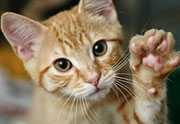
MONDAY, Dec. 16, 2013 (HealthDay News) — They may not hold the title of “man’s best friend,” but domesticated cats have been purring around the house for a long time.
Just how long? New research points back at least 5,300 years, at which point felines needing food and humans needing rodent killers may have entered into a mutually beneficial relationship.
“We all love cats, but they’re not a herd animal,” study co-author Fiona Marshall said. “They’re a solitary species, and so they’re really rare in archeological sites, which means we just don’t know much about their history with people.”
New scientific methods enabled Marshall’s team to show what led to cats’ domestication, she said. While dogs were attracted to people living as hunter-gatherers 9,000 to 20,000 years ago, it looks like cats were first domesticated as farmer’s animals, she said.
“Cats had a problem [obtaining] food, and so were attracted to our millet grain. And farmers had a problem with rodents, and found it useful to have cats eat them,” said Marshall, a professor of archaeology and acting chair of the anthropology department at Washington University of St. Louis. The findings are published in the Dec. 16 issue of the Proceedings of the National Academy of Sciences.
The authors point out that although cats are one of the most popular pet species in the world, information regarding the timing of their domestication has been sparse, based primarily on Egypt artifacts that date back about 4,000 years and show the animals were home dwellers then.
Additional anthropological evidence of the connection had also been unearthed in Cyprus, the team notes, suggesting some form of close contact (although not necessarily domesticity) dating back roughly 9,500 years. But an inability to connect the dots between these two periods has frustrated researchers for years.
The current revelation stems from an analysis of eight cat bones, attributed to at least two cats, unearthed near a small agricultural village known as Quanhucun in Shaanxi province, China. The cats were described as similar in size to domestic cats found today in Europe.
Radiocarbon dating identified the cats as having lived about 5,300 years ago — 3,000 years before the earliest domestic cats previously identified in China.
The researchers also subjected human, cat, and rodent bones to sophisticated isotope analyses, which indicated the three had similar eating patterns. All three had consumed “substantial” amounts of millet-based foods. This suggests the cats were devouring animals that lived on millet.
Also, one of the cats was found to have taken in more millet-based food, and less meat, than would have been expected. This pointed either to feline scavenging behavior or feeding of the cats by local residents, the authors surmised.
The team also described supporting archeological evidence — ceramic storage containers for millet, which suggested that human residents at the time had been coping with a rodent threat.
“Later, they are gradually domesticated as pet, I suppose,” said study author Yaowu Hu, of the Institute of Vertebrate Paleontology and Paleoanthropology at the Chinese Academy of Sciences in Beijing.
The next step, said Marshall, is to conduct an in-depth DNA analysis to precisely categorize the identity of the cats found in Quanhucun. That work, she said, is already slated to begin but without her involvement.
Cat lovers are taking the findings in stride. The non-profit Cat Fanciers Association of Alliance, Ohio, thinks the feline domestication process is not yet a done deal.
“Domestication of cats is an extremely gradual and ongoing evolutionary process,” said Joan Miller, chair of outreach and education for the association. Naturally cautious and independent by nature, “cats, as a species, have the least likelihood of being domesticated by humans,” Miller said. And their ability to hear, smell and see at night far exceeds that of humans, she added.
“They only will do what brings them reward, and cannot be trained to pull things, herd animals, or to perform work for humans,” Miller said.
“It is probable cats themselves chose domestication,” Miller said, “and that we are actually seeing this process continuing today.”
More information
For more about our feline friends, visit the Cat Fanciers Association.
Copyright © 2025 HealthDay. All rights reserved.

